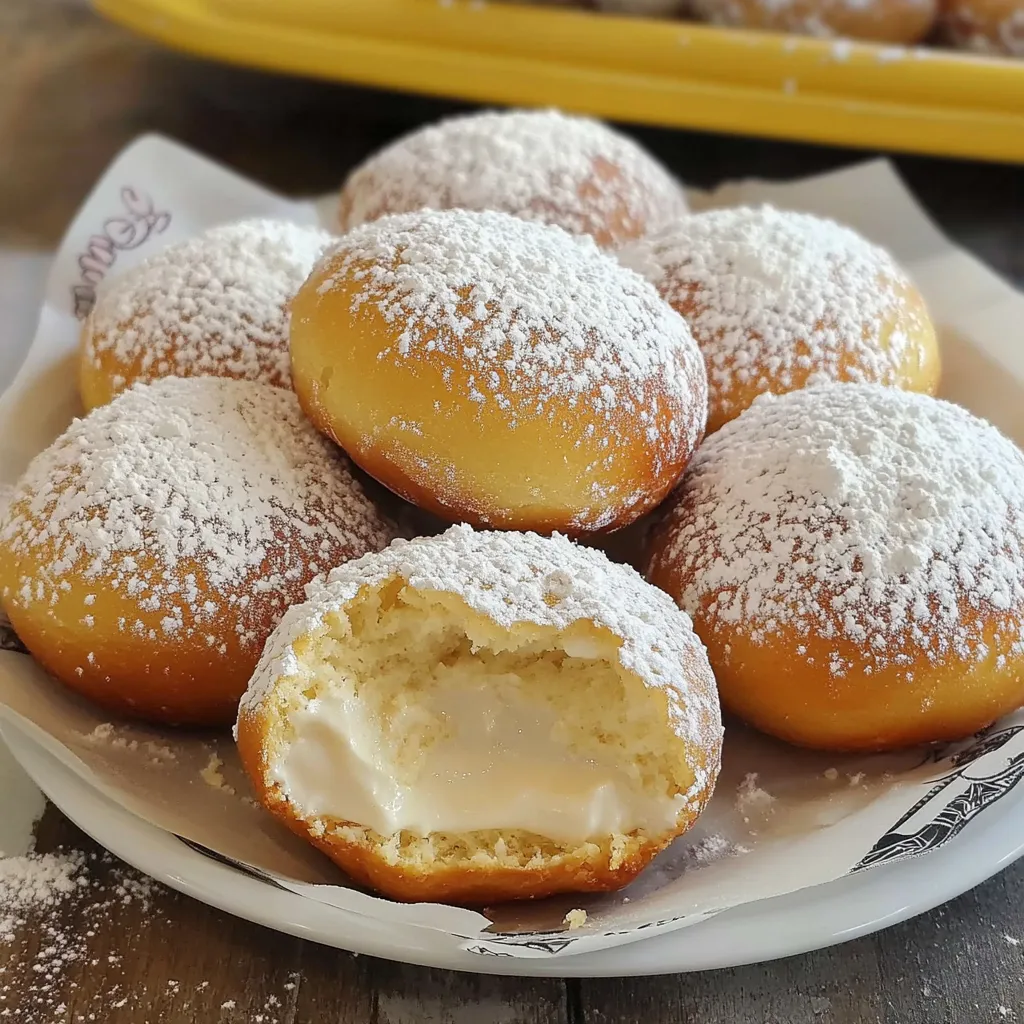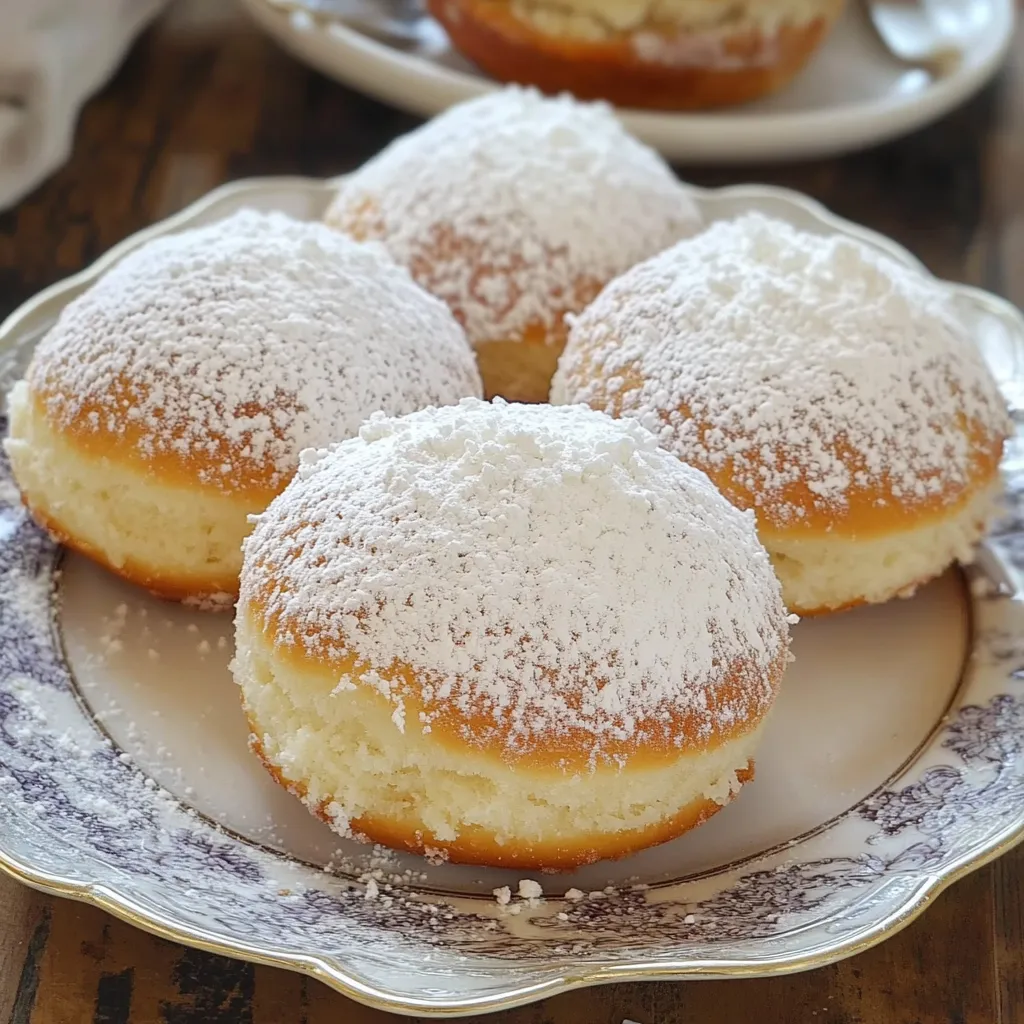 Pin it
Pin it
Soft pillowy dough fried until golden brown then filled with velvety custard creates an extraordinary breakfast treat that transports you directly to an Italian café. These bomboloni alla crema deliver an authentic Italian pastry experience with their delightful contrast between slightly crisp exterior and cloud-like interior surrounding rich, creamy filling. The final dusting of powdered sugar adds subtle sweetness while creating the classic visual appeal that makes these treats instantly recognizable throughout Italy.
I discovered these delightful pastries during my travels through northern Italy where local bakeries displayed trays of these sugar-dusted treasures each morning. After watching elderly bakers carefully craft each bombolone and sampling countless varieties across different regions, I developed this recipe that captures their authentic character while remaining accessible for home bakers with standard equipment and ingredients.
Essential Ingredients
- All-purpose flour: Provides the perfect structure—enough protein for proper development while remaining tender enough for delicate pastry texture.
- Fresh yeast: Contributes complex flavor development that dried yeast can't fully replicate—though instant dried yeast works as a substitute.
- Whole milk: Introduces necessary fat content and sugar that nourishes yeast while creating tender results impossible with lower-fat alternatives.
Preparation Method
- Dough Foundation:
- In a large mixing bowl, combine four cups all-purpose flour, a pinch of salt, and one-third cup granulated sugar. Create a well in the center for the liquid ingredients.
- Yeast Activation:
- Warm one cup whole milk to 110°F, ensuring it's warm but not hot. Pour into the flour well, then sprinkle 25 grams fresh crumbled yeast (or one packet instant dried yeast) over the milk. Let it sit for five minutes until foamy.
- Enrichment Addition:
- Add four ounces softened butter in small pieces and two beaten eggs to the flour mixture. Mix gently before kneading.
- Thorough Kneading:
- Knead for about eight minutes with a mixer using a dough hook or twelve minutes by hand until smooth and elastic.
- First Rising:
- Shape the dough into a smooth ball and place it in a greased bowl. Cover with a damp cloth and let it rise in a warm place for 90 minutes, allowing it to double in volume.
- Surface Preparation:
- Transfer the risen dough onto a lightly floured work surface. Roll to a consistent half-inch thickness.
- Shape Formation:
- Use a two-and-a-quarter-inch round cutter to cut circles from the dough without twisting. Arrange on a parchment-lined baking sheet.
- Secondary Rising:
- Cover dough rounds with a cloth and let them rest for ten minutes in a warm environment for a second rise.
- Oil Preparation:
- Heat vegetable oil to precisely 350°F in a heavy-bottomed pan, ensuring it's deep enough for the bomboloni to float while frying.
- Careful Frying:
- Gently lower dough rounds into the oil using a slotted spoon. Fry in batches for about two minutes per side until golden brown.
- Proper Drainage:
- Remove from the oil and place on a paper towel-lined tray to absorb excess oil. Let them cool for five minutes.
- Filling Preparation:
- Use a paring knife to make a small incision in each bombolone, creating a pocket for the filling.
- Filling Application:
- Fill a piping bag with prepared custard and insert into each bombolone, applying gentle pressure to evenly distribute the filling.
- Final Finishing:
- Dust the bomboloni generously with powdered sugar using a fine-mesh sieve for an even coating.
 Pin it
Pin it
My neighbor initially questioned whether homemade bomboloni could match those from professional bakeries until she sampled these during a weekend brunch. After her first bite, revealing the perfect balance between tender dough and creamy filling, she immediately requested the recipe. Now she prepares these for family celebrations, sometimes experimenting with seasonal fillings like summer berry creams or autumn-spiced custards.
Traditional Italian Connection
These beloved pastries represent centuries of Italian baking tradition, appearing in various forms throughout different regions. Northern Italian versions feature delicate dough with vanilla custard, while southern variations might include citrus or richer creams. Unlike American donuts, bomboloni have a lighter texture with pronounced yeast character and less sweetness in the dough.
Perfect Pairing Possibilities
Bomboloni pair beautifully with espresso for a traditional Italian breakfast. Cappuccino enhances the custard's vanilla notes, while serving them with a small glass of Vin Santo creates a sophisticated afternoon treat.
Filling Variation Inspiration
Chocolate custard adds indulgence, hazelnut cream provides a distinct Italian touch, and seasonal fruit creams introduce brightness. Amaretto-infused custard is perfect for festive occasions.
Texture Perfection Strategy
Proper kneading, double rising, and precise dough thickness ensure the perfect balance between a light interior and crisp exterior. Consistently maintaining 350°F oil temperature prevents undercooked centers or overbrowned exteriors.
Make-Ahead Possibilities
Prepare the dough and refrigerate overnight for slow fermentation, enhancing flavor. Alternatively, make the custard ahead and store it refrigerated, allowing easy assembly the next day.
Storage Considerations
Unfilled bomboloni maintain quality for one day at room temperature in an airtight container. Filled versions should be refrigerated and consumed within two days. Freeze unfilled bomboloni for longer storage, thawing before filling.
 Pin it
Pin it
Throughout my culinary journey, these Italian cream bombs have demonstrated that patience and technique transform simple ingredients into extraordinary creations. What might seem like a basic fried pastry reveals itself as a sophisticated achievement when prepared with traditional methods, delivering unparalleled satisfaction.
Frequently Asked Questions
- → Can I make the dough for Bomboloni ahead of time?
- Yes, you can make the dough a day ahead and let it rise slowly in the refrigerator overnight. This actually develops more flavor in the dough. After refrigeration, let the dough come to room temperature for about 30 minutes before rolling and cutting. Alternatively, you can freeze the cut dough rounds for up to a month - just thaw completely and let rise before frying.
- → What's the best oil for frying Bomboloni?
- Vegetable oil is recommended because it has a neutral flavor and high smoke point. Canola oil or sunflower oil also work well. Avoid olive oil for frying these donuts as its flavor would compete with the delicate taste of the bomboloni. The most important thing is to maintain a consistent temperature around 350°F (175°C) while frying.
- → Can I bake these Bomboloni instead of frying them?
- While traditional bomboloni are fried, you can bake them for a healthier option. Place the cut dough rounds on a parchment-lined baking sheet, brush with melted butter, and bake at 375°F (190°C) for about 15 minutes until golden brown. The texture will be different - more like sweet rolls than donuts - but still delicious.
- → What other fillings can I use for Bomboloni?
- Beyond traditional custard, bomboloni are delicious with many fillings. Try Nutella, fruit preserves (raspberry and apricot are popular), lemon curd, pastry cream flavored with chocolate or coffee, or sweetened ricotta. You can even fill them with savory options like cheese and ham for an appetizer version.
- → How long do Bomboloni stay fresh?
- Bomboloni are best enjoyed the day they're made, preferably within a few hours of frying. However, you can store unfilled bomboloni in an airtight container at room temperature for 1-2 days. Fill them just before serving to prevent sogginess. If you need to store filled bomboloni, keep them refrigerated for up to 24 hours and bring to room temperature before serving.
